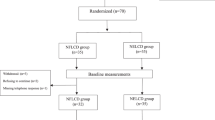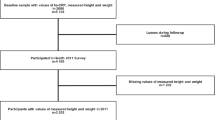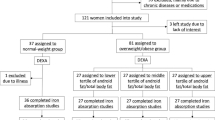Abstract
Aims:
To dissociate the possible differential effects of negative energy balance and reduction in body fat mass (FM) on inflammatory markers: C-reactive protein (CRP), fibrinogen, interleukin-6 (IL-6), haptoglobin, transferrin and the adipokines leptin and adiponectin.
Methods:
Thirty-three obese subjects (BMI: 34.0±3.1 kg/m2, age: 43.0±10.5 years, mean±s.d., 16 men) participated in a 20-week controlled dietary intervention divided into four periods. Weight reduction was induced by an 8-week low energy diet (3.4 MJ d−1) (LED-1) followed by a 4-week weight maintenance program (M-1). Subsequently participants underwent an additional 4-week LED (4.2 MJ d−1) (LED-2) followed by a final 4-week weight maintenance diet (M-2). Blood samples and anthropometrics were assessed at baseline and after LED-1, M-1, LED-2 and M-2.
Results:
Body weight was significantly reduced by 13% (13.7±4.0 kg, P<0.0001) after LED-1. However, a reduction in high-sensitive CRP (hs-CRP) by 35% (−1.1 (95% CI: −2.5:0.2) mg l−1, P=0.02) only became apparent after LED-2, which produced an additional weight loss of 2.9 kg compared to baseline, and it was maintained after M-2 (−1.0 (−1.4:0.4) mg l−1, P=0.02). Also IL-6 was reduced by 21% (−0.6 (−2.4:0.2) ng l−1, P=0.02) after M-2. The reductions in hs-CRP and IL-6 were both associated with reduction in FM but not body weight. Haptoglobin, transferrin and leptin were significantly reduced after both LED-1 and LED-2, but increased during weight maintenance. Adiponectin was not significantly changed during the intervention.
Conclusions:
The results suggest that, whereas haptoglobin and transferrin respond more rapidly and are more susceptible to the acute change in energy balance, a reduction in hs-CRP and IL-6 seems to be achieved by a reduction in FM when a new steady state has been established.
This is a preview of subscription content, access via your institution
Access options
Subscribe to this journal
Receive 12 print issues and online access
$259.00 per year
only $21.58 per issue
Buy this article
- Purchase on Springer Link
- Instant access to full article PDF
Prices may be subject to local taxes which are calculated during checkout


Similar content being viewed by others
References
Lee IM, Manson JE, Hennekens CH, Paffenbarger Jr RS . Body weight and mortality. A 27-year follow-up of middle-aged men. JAMA 1993; 270: 2823–2828.
Reaven GM . Syndrome X: 6 years later. J Intern Med Suppl 1994; 736: 13–22.
Stevens J, Cai J, Pamuk ER, Williamson DF, Thun MJ, Wood JL . The effect of age on the association between body-mass index and mortality. N Engl J Med 1998; 338: 1–7.
Haverkate F, Thompson SG, Pyke SD, Gallimore JR, Pepys MB . Production of C-reactive protein and risk of coronary events in stable and unstable angina. European Concerted Action on Thrombosis and Disabilities Angina Pectoris Study Group. Lancet 1997; 349: 462–466.
Jousilahti P, Salomaa V, Rasi V, Vahtera E, Palosuo T . The association of c-reactive protein, serum amyloid a and fibrinogen with prevalent coronary heart disease--baseline findings of the PAIS project. Atherosclerosis 2001; 156: 451–456.
Koenig W, Sund M, Frohlich M, Fischer HG, Lowel H, Doring A et al. C-Reactive protein, a sensitive marker of inflammation, predicts future risk of coronary heart disease in initially healthy middle-aged men: results from the MONICA (monitoring trends and determinants in cardiovascular disease) Augsburg Cohort Study, 1984–1992. Circulation 1999; 99: 237–242.
Retterstol L, Eikvar L, Bohn M, Bakken A, Erikssen J, Berg K . C-reactive protein predicts death in patients with previous premature myocardial infarction–a 10 year follow-up study. Atherosclerosis 2002; 160: 433–440.
Ridker PM, Cushman M, Stampfer MJ, Tracy RP, Hennekens CH . Inflammation, aspirin, and the risk of cardiovascular disease in apparently healthy men. N Engl J Med 1997; 336: 973–979.
Engstrom G, Hedblad B, Stavenow L, Lind P, Janzon L, Lindgarde F . Inflammation-sensitive plasma proteins are associated with future weight gain. Diabetes 2003; 52: 2097–2101.
Festa A, D'Agostino Jr R, Howard G, Mykkanen L, Tracy RP, Haffner SM . Chronic subclinical inflammation as part of the insulin resistance syndrome: the Insulin Resistance Atherosclerosis Study (IRAS). Circulation 2000; 102: 42–47.
Festa A, D'Agostino Jr R, Tracy RP, Haffner SM . Elevated levels of acute-phase proteins and plasminogen activator inhibitor-1 predict thedevelopment of type 2 diabetes: the insulin resistance atherosclerosis study. Diabetes 2002; 51: 1131–1137.
Gabay C, Kushner I . Acute-phase proteins and other systemic responses to inflammation. N Engl J Med 1999; 340: 448–454.
Ridker PM . High-sensitivity C-reactive protein: potential adjunct for global risk assessment in the primary prevention of cardiovascular disease. Circulation 2001; 103: 1813–1818.
Bruun JM, Lihn AS, Verdich C, Pedersen SB, Toubro S, Astrup A et al. Regulation of adiponectin by adipose tissue-derived cytokines: in vivo and in vitro investigations in humans. Am J Physiol Endocrinol Metab 2003; 285: E527–E533.
Esposito K, Pontillo A, Di PC, Giugliano G, Masella M, Marfella R et al. Effect of weight loss and lifestyle changes on vascular inflammatory markers in obese women: a randomized trial. JAMA 2003; 289: 1799–1804.
Kopp HP, Kopp CW, Festa A, Krzyzanowska K, Kriwanek S, Minar E et al. Impact of weight loss on inflammatory proteins and their association with the insulin resistance syndrome in morbidly obese patients. Arterioscler Thromb Vasc Biol 2003; 23: 1042–1047.
Ryan AS, Nicklas BJ . Reductions in plasma cytokine levels with weight loss improve insulin sensitivity in overweight and obese postmenopausal women. Diabetes Care 2004; 27: 1699–1705.
Heilbronn LK, Noakes M, Clifton PM . Energy restriction and weight loss on very-low-fat diets reduce C-reactive protein concentrations in obese, healthy women. Arterioscler Thromb Vasc Biol 2001; 21: 968–970.
Tchernof A, Nolan A, Sites CK, Ades PA, Poehlman ET . Weight loss reduces C-reactive protein levels in obese postmenopausal women. Circulation 2002; 105: 564–569.
Harris TB, Ferrucci L, Tracy RP, Corti MC, Wacholder S, Ettinger Jr WH et al. Associations of elevated interleukin-6 and C-reactive protein levels with mortality in the elderly. Am J Med 1999; 106: 506–512.
Ridker PM, Hennekens CH, Buring JE, Rifai N . C-reactive protein and other markers of inflammation in the prediction of cardiovascular disease in women. N Engl J Med 2000; 342: 836–843.
James WP, Astrup A, Finer N, Hilsted J, Kopelman P, Rossner S et al. Effect of sibutramine on weight maintenance after weight loss: a randomised trial. STORM Study Group. Sibutramine Trial of Obesity Reduction and Maintenance. Lancet 2000; 356: 2119–2125.
Marckmann P, Toubro S, Astrup A . Sustained improvement in blood lipids, coagulation, and fibrinolysis after major weight loss in obese subjects. Eur J Clin Nutr 1998; 52: 329–333.
Wadden TA, Anderson DA, Foster GD . Two-year changes in lipids and lipoproteins associated with the maintenance of a 5% to 10% reduction in initial weight: some findings and some questions. Obes Res 1999; 7: 170–178.
Chiellini C, Santini F, Marsili A, Berti P, Bertacca A, Pelosini C et al. Serum haptoglobin: a novel marker of adiposity in humans. J Clin Endocrinol Metab 2004; 89: 2678–2683.
Delanghe JR, Langlois MR, De BD, Mak R, Capel P, Van RL et al. Discriminative value of serum amyloid A and other acute-phase proteins for coronary heart disease. Atherosclerosis 2002; 160: 471–476.
Kelleher PC, Phinney SD, Sims EA, Bogardus C, Horton ES, Bistrian BR et al. Effects of carbohydrate-containing and carbohydrate-restricted hypocaloric and eucaloric diets on serum concentrations of retinol-binding protein, thyroxine-binding prealbumin and transferrin. Metabolism 1983; 32: 95–101.
Kopp CW, Kopp HP, Steiner S, Kriwanek S, Krzyzanowska K, Bartok A et al. Weight loss reduces tissue factor in morbidly obese patients. Obes Res 2003; 11: 950–956.
Kopp HP, Krzyzanowska K, Mohlig M, Spranger J, Pfeiffer AF, Schernthaner G . Effects of marked weight loss on plasma levels of adiponectin, markers of chronic subclinical inflammation and insulin resistance in morbidly obese women. Int J Obes (Lond) 2005; 29: 766–771.
Lubrano C, Cornoldi A, Pili M, Falcone S, Brandetti F, Fabbrini E et al. Reduction of risk factors for cardiovascular diseases in morbid-obese patients following biliary-intestinal bypass: 3 years' follow-up. Int J Obes Relat Metab Disord 2004; 28: 1600–1606.
Verdich C, Madsen JL, Toubro S, Buemann B, Holst JJ, Astrup A . Effect of obesity and major weight reduction on gastric emptying. Int J Obes Relat Metab Disord 2000; 24: 899–905.
Haffner SM, Miettinen H, Stern MP . The homeostasis model in the San Antonio Heart Study. Diabetes Care 1997; 20: 1087–1092.
Friedewald WT, Levy RI, Fredrickson DS . Estimation of the concentration of low-density lipoprotein cholesterol in plasma, without use of the preparative ultracentrifuge. Clin Chem 1972; 18: 499–502.
Pearson TA, Mensah GA, Alexander RW, Anderson JL, Cannon III RO, Criqui M et al. Markers of inflammation and cardiovascular disease: application to clinical and public health practice: A statement for healthcare professionals from the Centers for Disease Control and Prevention and the American Heart Association. Circulation 2003; 107: 499–511.
Laimer M, Ebenbichler CF, Kaser S, Sandhofer A, Weiss H, Nehoda H et al. Markers of chronic inflammation and obesity: a prospective study on the reversibility of this association in middle-aged women undergoing weight loss by surgical intervention. Int J Obes Relat Metab Disord 2002; 26: 659–662.
Shargorodsky M, Fleed A, Boaz M, Gavish D, Zimlichman R . The effect of a rapid weight loss induced by laparoscopic adjustable gastric banding on arterial stiffness, metabolic and inflammatory parameters in patients with morbid obesity. Int J Obes (London) 2006; 30: 1632–1638.
Madsen EL, Rissanen A, Bruun JM, Skogstrand K, Tonstad S, Hougaard DM et al. Weight loss larger than 10% is needed for general improvement of levels of circulating adiponectin and markers of inflammation in obese subjects: a 3-year weight loss study. Eur J Endocrinol 2008; 158: 179–187.
Dvorakova-Lorenzova A, Suchanek P, Havel PJ, Stavek P, Karasova L, Valenta Z et al. The decrease in C-reactive protein concentration after diet and physical activity induced weight reduction is associated with changes in plasma lipids, but not interleukin-6 or adiponectin. Metabolism 2006; 55: 359–365.
Sharman MJ, Volek JS . Weight loss leads to reductions in inflammatory biomarkers after a very-low-carbohydrate diet and a low-fat diet in overweight men. Clin Sci (Lond) 2004; 107: 365–369.
Valsamakis G, McTernan PG, Chetty R, Al DN, Field A, Hanif W et al. Modest weight loss and reduction in waist circumference after medical treatment are associated with favorable changes in serum adipocytokines. Metabolism 2004; 53: 430–434.
Bastard JP, Jardel C, Bruckert E, Blondy P, Capeau J, Laville M et al. Elevated levels of interleukin 6 are reduced in serum and subcutaneous adipose tissue of obese women after weight loss. J Clin Endocrinol Metab 2000; 85: 3338–3342.
Bruun JM, Verdich C, Toubro S, Astrup A, Richelsen B . Association between measures of insulin sensitivity and circulating levels of interleukin-8, interleukin-6 and tumor necrosis factor-alpha. Effect of weight loss in obese men. Eur J Endocrinol 2003; 148: 535–542.
Gallistl S, Sudi KM, Aigner R, Borkenstein M . Changes in serum interleukin-6 concentrations in obese children and adolescents during a weight reduction program. Int J Obes Relat Metab Disord 2001; 25: 1640–1643.
Ditschuneit HH, Flechtner-Mors M, Adler G . Fibrinogen in obesity before and after weight reduction. Obes Res 1995; 3: 43–48.
Fanari P, Somazzi R, Nasrawi F, Ticozzelli P, Grugni G, Agosti R et al. Haemorheological changes in obese adolescents after short-term diet. Int J Obes Relat Metab Disord 1993; 17: 487–494.
Primrose JN, Davies JA, Prentice CR, Hughes R, Johnston D . Reduction in factor VII, fibrinogen and plasminogen activator inhibitor-1 activity after surgical treatment of morbid obesity. Thromb Haemost 1992; 68: 396–399.
Brinkworth GD, Noakes M, Parker B, Foster P, Clifton PM . Long-term effects of advice to consume a high-protein, low-fat diet, rather than a conventional weight-loss diet, in obese adults with type 2 diabetes: one-year follow-up of a randomised trial. Diabetologia 2004; 47: 1677–1686.
Clifton PM, Keogh JB, Foster PR, Noakes M . Effect of weight loss on inflammatory and endothelial markers and FMD using two low-fat diets. Int J Obes (London) 2005; 29: 1445–1451.
Keogh JB, Brinkworth GD, Noakes M, Belobrajdic DP, Buckley JD, Clifton PM . Effects of weight loss from a very-low-carbohydrate diet on endothelial function and markers of cardiovascular disease risk in subjects with abdominal obesity. Am J Clin Nutr 2008; 87: 567–576.
Rissanen P, Vahtera E, Krusius T, Uusitupa M, Rissanen A . Weight change and blood coagulability and fibrinolysis in healthy obese women. Int J Obes Relat Metab Disord 2001; 25: 212–218.
van Dielen FM, Buurman WA, Hadfoune M, Nijhuis J, Greve JW . Macrophage inhibitory factor, plasminogen activator inhibitor-1, other acute phase proteins, and inflammatory mediators normalize as a result of weight loss in morbidly obese subjects treated with gastric restrictive surgery. J Clin Endocrinol Metab 2004; 89: 4062–4068.
Due A, Toubro S, Stender S, Skov AR, Astrup A . The effect of diets high in protein or carbohydrate on inflammatory markers in overweight subjects. Diabetes Obes Metab 2005; 7: 223–229.
Sorensen LB, Raben A, Stender S, Astrup A . Effect of sucrose on inflammatory markers in overweight humans. Am J Clin Nutr 2005; 82: 421–427.
Clifton PM . Diet and C-reactive protein. Curr Atheroscler Rep 2003; 5: 431–436.
O'Brien KD, Brehm BJ, Seeley RJ, Bean J, Wener MH, Daniels S et al. Diet-induced weight loss is associated with decreases in plasma serum amyloid a and C-reactive protein independent of dietary macronutrient composition in obese subjects. J Clin Endocrinol Metab 2005; 90: 2244–2249.
Acknowledgements
We thank John Lind, Kirsten Bryde Rasmussen and Martin Kreutzer for their expert technical assistance and Ole Hels for his expert statistical assistance. The study was supported by a grant from Dansk Droge A/S, Ishøj, Denmark. No authors have any financial or personal interest in Dansk Droge A/S, Ishøj, Denmark.
Author information
Authors and Affiliations
Corresponding author
Rights and permissions
About this article
Cite this article
Belza, A., Toubro, S., Stender, S. et al. Effect of diet-induced energy deficit and body fat reduction on high-sensitive CRP and other inflammatory markers in obese subjects. Int J Obes 33, 456–464 (2009). https://doi.org/10.1038/ijo.2009.27
Received:
Revised:
Accepted:
Published:
Issue Date:
DOI: https://doi.org/10.1038/ijo.2009.27
Keywords
This article is cited by
-
High estradiol levels during a long agonist IVF protocol are associated with decreased food intake, higher leptin concentrations, and lower levels of high-sensitivity C-reactive protein
Archives of Gynecology and Obstetrics (2023)
-
Neurological Complications After Bariatric Surgery in Turkish People
SN Comprehensive Clinical Medicine (2021)
-
The efficacy of a high protein/low glycemic index diet intervention in non-obese patients with asthma
European Journal of Clinical Nutrition (2018)
-
Intermittent Fasting (Alternate Day Fasting) in Healthy, Non-obese Adults: Protocol for a Cohort Trial with an Embedded Randomized Controlled Pilot Trial
Advances in Therapy (2018)
-
Circulating Haptoglobin and Metabolic Syndrome in Renal Transplant Recipients
Scientific Reports (2017)



